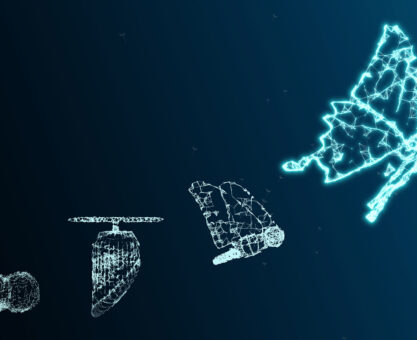While the race to full connectivity and occupying our place within Industry4.0 is on the top of almost all companies operating a field service division, the reality for many OEMs is that they have large existing install based of legacy assets being used out in the field that remain unconnected…
It is something of a regularly occurring phenomenon at times of rapid development for there to be a challenging dichotomy between the old and the new. The fourth industrial revolution that we are currently in the midst of is no different. As we move from a reliance on the mechanical to embrace the digital, it is perhaps understandable that the majority of our attention lies towards the connected world of industry 4.0.
However, let us not forget that the previous century also was one of innovation and engineering excellence. Much of the older assets still operating in the field are far from obsolete, being from an era before planned obsolescence existed and things were built to last. So the complete overhaul of our entire install base in a drive to connect everything is perhaps not only costly but in some scenarios also unnecessary, for the time being at least.
However, the challenge then becomes how do we make those ‘dumb machines’ smart so they can be incorporated into a more modern approach to service delivery that is born alongside the google native generation?
As Coen Jeukens, VP Global Customer Transformation, ServiceMax outlines “When we attend the various service industry conferences, when we are listening to the people on the stage, the focus is always about service excellence. We are always looking to the future and outlining the service nirvana we are aiming for.
“Yet, many of us have a lot of legacy products out there that don’t have all the necessary connectivity capabilities, if any. So, one of the key questions we need to address is ‘how do we incorporate a service model in which we can deliver a consistent level of service across the newer generation of assets, while still maintaining the older assets in our fleet as well?”
“The key questions are which assets do we have the biggest install base of and also after factoring in end-of-service life where is the most potential…”
– Jason Smith, 3D Systems
It is a critical and pertinent question for sure and one that a vast number of field service organisations are likely to be facing in several different verticals, even in younger vertical sectors such as the additive manufacturing market.
“The first thing we have done in this area is to make sure all current production models are enabled to be connected. With the older machines, then that is the next project. With all our new production machines now covered, we are now starting to look back to what machines can we connect that are legacy product,” explains Jason Smith, Director of Field Service, EMEA, 3D Systems Corporation.
“For us, the key questions are which assets do we have the biggest install base of and also after factoring in end-of-service life where is the most potential?
“Once we have established this then we can get a payback. However, even then we do get some push back on connecting legacy assets. Some of our customers, particularly the bigger ones in industries such as automotive and aerospace, are very protective of their network, so that is an issue we need to overcome – even though we have excellent security protocols in place,” Smith adds.
One organisation that has a vast range of asset ages still active in the field is Mining and Aggregates specialist Outotec. Like many other companies in the heavy manufacturing sector have assets still in use that are often twice as old if not more than the engineers sent to maintain them.
“Some of our equipment is close to seventy or even eighty years old, so we’ve got lots of legacy assets, but we also have a lot of new equipment that is either connected or ready to be connected.”
However, for Roux and his colleagues at Outotec, one of the biggest problems they face is when it comes to actual connectivity itself, particularly in many of the extremely remote locations where their assets are located.
As Roux explains; “Our issue is getting the signal off of the site. Even though we have best-in-class security protocols and are using the Microsoft Azure platform, a lot of customers are still very restrictive about that – especially when we are connecting to their networks. So we are finding more and more we are having to provide our own connection off of site whether that be connecting with 3G or putting a satellite out there.
“So, from my experience connecting to our customers’ networks, be it with new installs or connecting legacy assets is extremely challenging.”
Connecting the Assets in the Field
Roux’s point highlights an increasingly prevalent challenge for many field service organisations.
While the benefits of a connected world are not only well documented but also increasingly promoted as the ‘way of future’, the reality is that for many service organisations and OEMs achieving asset connectivity is more challenging than it perhaps should be. However, one potential solution lies not within the technology but more simply within allowing customers autonomy which lies at the heart of VBR Turbines‘ approach as Patrick Jansen outlined.
“We were also finding the same challenges as Christo has discussed, in terms of what customers would allow to sit on their networks,” he explained.
“Our solution was to ensure that the system used for log-in by our customers was kept completely separate from the system used for our diagnostic tools. This is because anyone logging into a system of a customer is a potential hazard for them, and IT teams don’t particularly like having what could be seen as a vulnerability added to their network.
“It always comes down to acknowledging the fact that there is some risk, but also understanding what is the added value for them [the customer] …”
– Patrick Jansen, VBR Turbines
“So we said internally, ‘OK if we want to sell remote diagnostics, let’s make sure there is not an option for us to log in and also make sure the hardware is not there to facilitate that.’ With the reasoning being that this then takes away quite a lot of risk from the customer.
“Prior to this, we used to provide our customers with a piece of hardware to collect all the data from them, but we stopped providing that and now explain to the customer it is their responsibility to provide us with the data that we need to provide the remote services. Strangely enough, this also takes away a big hurdle for the customer because their IT team is now in charge, so accessing data is often no longer a barrier anymore.”
This is an interesting and effective approach. However, it is also reliant on an organisation having a customer-centric approach to establishing service delivery strategies as it is not a one size fits all approach and by neccessity requires a large degree of flexibility on the part of VBR Turbines as the service provider.
“In terms of real-time data needs, for us, it depends very much on the customer. Some of our customers have overcapacity so if an asset is down for two days whilst they send data it is not a problem. For other customers, the assets are critical and it is these customers who are more likely to set up a system with a continuous flow of data,” Jansen explained.
“It always comes down to acknowledging the fact that there is some risk, but also understanding what is the added value for them [the customer]. If the added value is big enough for them, we find they will accept more risk and run regular or even real-time data feeds.
“That has been our approach to balancing this equation out – allowing our customers to decide. It is open for them, if they think it is beneficial for them to provide real-time data, they can do so. If they see less benefit in our ability to respond as swiftly as possible and they would prefer to minimise their risk exposure, they can choose that route instead.”
The introduction of shared ownership of the problem with the customer is an excellent example of Peter Drucker’s famous theory of the Outside-In approach to business and brings a very real focus on the relationship between service provider and customer being one of genuine partnership.
“It is interesting because by providing the customers with a level of autonomy it can diffuse the conversation somewhat,” added Kris Oldland, Editor-in-Chief, Field Service News.
“By offering that degree of transparency, by giving them control it can disarm these common concerns around security and the perennial question of ‘what are you going to do with my data?’”
Want to know more? There is an Executive Briefing from this Field Service Think Tank Session which is available in the premium content library.













